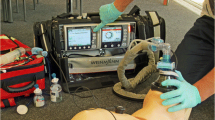Abstract
Objective. The medical practitioner is faced with an increasing list of protocols and algorithms related to patient care. These recommendations are often difficult to recall, particularly in stressful emergency situations. Using advanced cardiac life support (ACLS) protocols, we built a computer-based system to exhibit precompiled response plans for medical emergencies. To validate the usefulness of this prompting device, we tested application of two of the nine ACLS algorithms, pulseless ventricular fibrillation/ventricular tachycardia (Vfib/Vtach) and bradycardia, in a simulated operating room (OR) environment.Methods. The system utilized the software authoring system IconAuthor (Aimtec Inc., Nashua, NH) and a touch-screen monitor (DiamondScan, Microtouch, Methuen, MA). Prior to testing our system, all 39 subjects were given time to familiarize themselves with its operation. Subsequently, all subjects were videotaped while managing a standard simulated anesthetic. During the anesthetic, the subjects were presented with two emergency scenarios, not viewed during the familiarization period. The electrocardiographic (EKG) signals for normal sinus rhythm, ventricular fibrillation, and second-degree heart block were presented. By random selection, the prompter was available to half of the subjects for help with arrhythmia management (experimental group), while to half it was not (control group).Results. A total of 39 subjects completed the exercise. Use of the prompter enabled significantly more subjects to administer correct drugs and dosages during ventricular fibrillation. The correct lidocaine dose was chosen more often by the experimental group than by the control (p=0.015); similarly MgSO4 was appropriately ordered more often in the experimental group (p=0.003). During second-degree heart block, atropine was correctly followed with a dopamine infusion (p=0.004), and epinephrine infusion was ordered for refractory bradycardia (p=0.002) more often in the experimental than the control group.Conclusions. These data demonstrate the value of a prompting device at the anesthesia workstation. We foresee the use of such prompters in many areas of medicine.
Similar content being viewed by others
References
Schwid HA, O'Donnell D. Anesthesiologists' management of simulated critical incidents. Anesthesiology 1992;76:495–501
Gaba DM, DeAnda A. A comprehensive anesthesia simulation environment: Re-creating the operating room for research and training. Anesthesiology 1988;69:387–394
Gaba DM. The response of anesthesia trainees to simulated critical incidents. Anesth Analg 1989;68:444–451
Gaba DM. Human error in anesthetic mishaps. Int Anesthesiol Clin 1989;27:137–147
Rasmussen J. Cognitive control and human error mechanisms. In: Rasmussen J, Duncan K, Leplat J, eds. New technology and human error. Chichester, UK: Wiley, 1987:43–52
Cooper JB, Gaba DM. Strategy for preventing anesthesia accidents. Int Anesthesiol Clin 1989;27:148–152
Williamson JA, Webb RK, Sellen A, et al. Crisis management—validation of an algorithm by analysis of 2000 incident reports. Anaesth Intens Care 1993;21:579–592
Williamson JA, Webb RK, Sellen A, et al. Human failure: An analysis of 2000 accident reports. Anaesth Intens Care 1993;21:678–683
Guidelines for cardiopulmonary resuscitation and emergency cardiac care. Recommendations of the 1992 National Conference, Emergency Cardiac Care Committee, American Heart Association. JAMA 1992;268:2199–2241
Author information
Authors and Affiliations
Additional information
This study was made possible by a grant from the Anesthesia Patient Safety Foundation. Results were presented, in part, at the meeting of the STA/SEA Orlando, Florida, January 1994.
Rights and permissions
About this article
Cite this article
Schneider, A.J.L., Murray, W.B., Mentzer, S.C. et al. “Helper:” A critical events prompter for unexpected emergencies. J Clin Monitor Comput 11, 358–364 (1995). https://doi.org/10.1007/BF01616741
Received:
Revised:
Accepted:
Issue Date:
DOI: https://doi.org/10.1007/BF01616741




